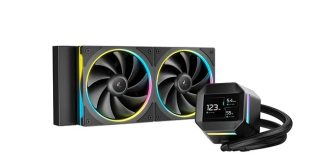To test all of the different AIO coolers we have, we devised an easily repeatable test with no variables other than the coolers themselves. This ensures that all of the figures are directly comparable.
Test rig
Using an open-air test bench, we deployed an Intel Core i7-4790K plugged into a Gigabyte Z97X-SOC Force motherboard. Alongside this was 16GB of 2400MHz Corsair Vengeance DDR3, as well as a 120GB OCZ Trion 150 SSD. Powering everything was a Corsair CX500M.
The test process
Testing each cooler involved taking a total of 4 temperature readings per cooler. First, we measured the idle temperature of the i7-4790K at stock speeds (turbo boost disabled), before measuring its temperature under load at stock speeds. Next, we overclocked the CPU to 4.5GHz using a 1.3 Vcore, ensuring greater heat output. In its overclocked state we then measured the idle and load temperatures of the CPU again.
To ward off potential comments or questions, we know 4.5GHz using a 1.3 Vcore is a ‘bad’ overclock – this particular CPU could reach that frequency at closer to 1.2 on the Vcore, which is more efficient. That is not the point, however. We are trying to stress the coolers to see how they deal with excess heat … hence the high Vcore.
Where possible, each cooler’s fans were plugged directly into the motherboard using the CPU_Fan or CPU_Opt headers. Some AIOs, however, ship with their own fan controllers or PWM hubs. If we were unable to plug the fans directly into the motherboard, it is specified on the cooler's page in this review.
An idle reading comes from leaving Windows on the desktop for 15 minutes. A load reading comes from running Prime95’s (version 26.6) Small FFTs test for 15 minutes – enough time for temperatures to plateau.
Noise output
Unfortunately I was unable to properly measure the sound output of the coolers using a digital sound meter. This is because I am based in London (with high ambient noise levels) while things are compounded by the fact that building works are current taking place directly next door to me. Using a sound meter then would not be a fair test as there are variables out of my control. However, for each cooler I will try my best to subjectively describe the noise output in a helpful manner.
A note on cooler installation
All comments about the ease (or lack of) of installing the coolers refers to installing them on a LGA 1150 motherboard. LGA 2011 or AMD installation may well be very similar, but we cannot comment on this.
 KitGuru KitGuru.net – Tech News | Hardware News | Hardware Reviews | IOS | Mobile | Gaming | Graphics Cards
KitGuru KitGuru.net – Tech News | Hardware News | Hardware Reviews | IOS | Mobile | Gaming | Graphics Cards



Sadly missing the NZXT ones (and EKWB, but these barely ever get tested) and the main thing I’m missing is a table with the actual noise data. The Deepcool is very quiet and performs less good than the Corsair when the CPU is overclocked, but how much more noise does the H100i make in comparison to keep the temp lower?
Would also be nice to have it tested based on dB, so we can see if we set the other cooler to a quieter mode/noisier mode and see if it then performs equally to the others.
I have an H105 which I had to replace thanks to space issues. It was pretty damned quiet. And yes, I can attest to them being ridiculously cool, even at low fan speeds.
This is the older model, mind you.
You do that now go away from here and take your web money with you!
I am trying to decide between the Corsair h100i v2 and Alphacool Eisbaer 240. I wish that the Eisbaer 240, Kraken x52, and Fractal Design S24 were tested against them too